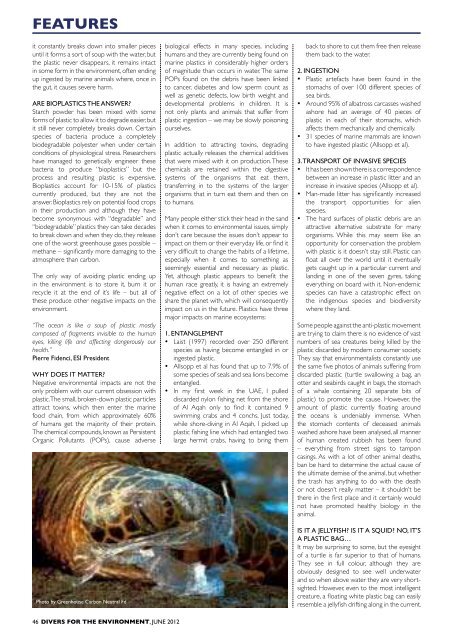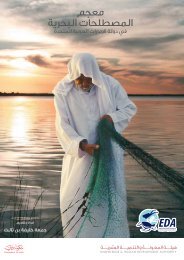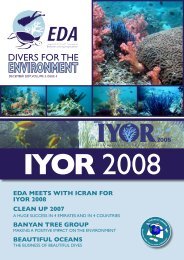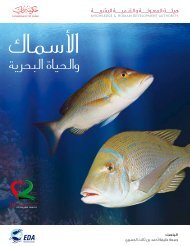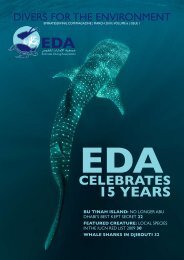Download - Emirates Diving Association
Download - Emirates Diving Association
Download - Emirates Diving Association
You also want an ePaper? Increase the reach of your titles
YUMPU automatically turns print PDFs into web optimized ePapers that Google loves.
FEATURES<br />
FEATURES<br />
it constantly breaks down into smaller pieces<br />
until it forms a sort of soup with the water, but<br />
the plastic never disappears, it remains intact<br />
in some form in the environment, often ending<br />
up ingested by marine animals where, once in<br />
the gut, it causes severe harm.<br />
Are bioplastics the answer<br />
Starch powder has been mixed with some<br />
forms of plastic to allow it to degrade easier, but<br />
it still never completely breaks down. Certain<br />
species of bacteria produce a completely<br />
biodegradable polyester when under certain<br />
conditions of physiological stress. Researchers<br />
have managed to genetically engineer these<br />
bacteria to produce “bioplastics” but the<br />
process and resulting plastic is expensive.<br />
Bioplastics account for 10-15% of plastics<br />
currently produced, but they are not the<br />
answer. Bioplastics rely on potential food crops<br />
in their production and although they have<br />
become synonymous with “degradable” and<br />
“biodegradable” plastics they can take decades<br />
to break down and when they do, they release<br />
one of the worst greenhouse gases possible –<br />
methane – significantly more damaging to the<br />
atmosphere than carbon.<br />
The only way of avoiding plastic ending up<br />
in the environment is to store it, burn it or<br />
recycle it at the end of it’s life – but all of<br />
these produce other negative impacts on the<br />
environment.<br />
“The ocean is like a soup of plastic mostly<br />
composed of fragments invisible to the human<br />
eyes, killing life and affecting dangerously our<br />
health.”<br />
Pierre Fidenci, ESI President<br />
Why does it matter<br />
Negative environmental impacts are not the<br />
only problem with our current obsession with<br />
plastic. The small, broken-down plastic particles<br />
attract toxins, which then enter the marine<br />
food chain, from which approximately 60%<br />
of humans get the majority of their protein.<br />
The chemical compounds, known as Persistent<br />
Organic Pollutants (POPs), cause adverse<br />
Photo by Greenhouse Carbon Neutral Fd<br />
biological effects in many species, including<br />
humans and they are currently being found on<br />
marine plastics in considerably higher orders<br />
of magnitude than occurs in water. The same<br />
POPs found on the debris have been linked<br />
to cancer, diabetes and low sperm count as<br />
well as genetic defects, low birth weight and<br />
developmental problems in children. It is<br />
not only plants and animals that suffer from<br />
plastic ingestion – we may be slowly poisoning<br />
ourselves.<br />
In addition to attracting toxins, degrading<br />
plastic actually releases the chemical additives<br />
that were mixed with it on production. These<br />
chemicals are retained within the digestive<br />
systems of the organisms that eat them,<br />
transferring in to the systems of the larger<br />
organisms that in turn eat them and then on<br />
to humans.<br />
Many people either stick their head in the sand<br />
when it comes to environmental issues, simply<br />
don’t care because the issues don’t appear to<br />
impact on them or their everyday life, or find it<br />
very difficult to change the habits of a lifetime,<br />
especially when it comes to something as<br />
seemingly essential and necessary as plastic.<br />
Yet, although plastic appears to benefit the<br />
human race greatly, it is having an extremely<br />
negative effect on a lot of other species we<br />
share the planet with, which will consequently<br />
impact on us in the future. Plastics have three<br />
major impacts on marine ecosystems:<br />
1. Entanglement<br />
• Laist (1997) recorded over 250 different<br />
species as having become entangled in or<br />
ingested plastic.<br />
• Allsopp et al has found that up to 7.9% of<br />
some species of seals and sea lions become<br />
entangled.<br />
• In my first week in the UAE, I pulled<br />
discarded nylon fishing net from the shore<br />
of Al Aqah only to find it contained 9<br />
swimming crabs and 4 conchs. Just today,<br />
while shore-diving in Al Aqah, I picked up<br />
plastic fishing line which had entangled two<br />
large hermit crabs, having to bring them<br />
back to shore to cut them free then release<br />
them back to the water.<br />
2. Ingestion<br />
• Plastic artefacts have been found in the<br />
stomachs of over 100 different species of<br />
sea birds.<br />
• Around 95% of albatross carcasses washed<br />
ashore had an average of 40 pieces of<br />
plastic in each of their stomachs, which<br />
affects them mechanically and chemically.<br />
• 31 species of marine mammals are known<br />
to have ingested plastic (Allsopp et al).<br />
3. Transport of invasive species<br />
• It has been shown there is a correspondence<br />
between an increase in plastic litter and an<br />
increase in invasive species (Allsopp et al).<br />
• Man-made litter has significantly increased<br />
the transport opportunities for alien<br />
species.<br />
• The hard surfaces of plastic debris are an<br />
attractive alternative substrate for many<br />
organisms. While this may seem like an<br />
opportunity for conservation the problem<br />
with plastic is it doesn’t stay still. Plastic can<br />
float all over the world until it eventually<br />
gets caught up in a particular current and<br />
landing in one of the seven gyres, taking<br />
everything on board with it. Non-endemic<br />
species can have a catastrophic effect on<br />
the indigenous species and biodiversity<br />
where they land.<br />
Some people against the anti-plastic movement<br />
are trying to claim there is no evidence of vast<br />
numbers of sea creatures being killed by the<br />
plastic discarded by modern consumer society.<br />
They say that environmentalists constantly use<br />
the same five photos of animals suffering from<br />
discarded plastic (turtle swallowing a bag, an<br />
otter and seabirds caught in bags, the stomach<br />
of a whale containing 20 separate bits of<br />
plastic) to promote the cause. However, the<br />
amount of plastic currently floating around<br />
the oceans is undeniably immense. When<br />
the stomach contents of deceased animals<br />
washed ashore have been analysed, all manner<br />
of human created rubbish has been found<br />
– everything from street signs to tampon<br />
casings. As with a lot of other animal deaths,<br />
ban be hard to determine the actual cause of<br />
the ultimate demise of the animal, but whether<br />
the trash has anything to do with the death<br />
or not doesn’t really matter – it shouldn’t be<br />
there in the first place and it certainly would<br />
not have promoted healthy biology in the<br />
animal.<br />
Is it a JELLYFISH Is it a squid No, it’s<br />
a plastic bag…<br />
It may be surprising to some, but the eyesight<br />
of a turtle is far superior to that of humans.<br />
They see in full colour, although they are<br />
obviously designed to see well underwater<br />
and so when above water they are very shortsighted.<br />
However, even to the most intelligent<br />
creature, a floating white plastic bag can easily<br />
resemble a jellyfish drifting along in the current.<br />
Photo by Chris Jordan<br />
The UAE is very privileged in having 4 of<br />
the 7 species of sea turtles resident on our<br />
shores. However, if plastic pollution continues<br />
at current trends, this situation may not last.<br />
All seven species of sea turtles currently carry<br />
“endangered” status on the IUCN’s Red List.<br />
Plastic pollution only makes their situations<br />
more urgent.<br />
In 2009, marine biologists from Disney’s<br />
Animal Programs discovered a green sea<br />
turtle off Melbourne Beach, Florida, who was<br />
seemingly having difficulty digesting food. Upon<br />
investigation, the biologists found a piece of<br />
plastic was lodged in the gastrointestinal tract<br />
of the turtle. Once the plastic was removed,<br />
the turtle proceeded to defecate 74 foreign<br />
objects in the following month including latex<br />
balloons, various types of string, nine different<br />
types of soft plastic, four types of hard plastic,<br />
a piece of carpet-like material and, horrifyingly,<br />
two tar balls. For one turtle to have so many<br />
foreign items, all due to human disposal, is<br />
more than worrying and is a big eye-opener in<br />
to what we are doing to our planet with our<br />
current “disposable” lifestyle.<br />
In November 2008, “Whitey” a 10-foot-long<br />
crocodile tagged as part of an Australian<br />
government wildlife-tracking program was<br />
found dead. Examination showed it had<br />
consumed 25 plastic shopping bags and<br />
garbage bags.<br />
Current conservation estimates suggest that<br />
plastic kills over 100,000 marine animals<br />
and 1,000,000 birds every year. The number<br />
of fish killed is hard to estimate, but it could<br />
be millions. It doesn’t take a huge stretch of<br />
imagination to consider one plastic bag being<br />
able of killing more than one animal in it’s life,<br />
given that they survive in the environment for<br />
so long.<br />
Why is there so much plastic in<br />
the oceans<br />
In 2010, Cinque Terre, Italy actually banned<br />
plastic bottles from the region as it was<br />
estimated 2 million were left behind on the<br />
region’s beaches every year. Beach clean-ups<br />
are no doubt of benefit to the immediate<br />
environment. Too many people are in the<br />
habit of standing up and walking away from<br />
the beach, leaving their litter behind. For some,<br />
it seems out of sight really is out of mind.<br />
Many plastic bags, bottles and cigarette ends<br />
are removed from beaches on clean ups, but<br />
is it merely delaying the inevitable 80% of<br />
the rubbish collected in the oceans originates<br />
from rubbish intended for landfill, where it has<br />
blown from either bins or the landfill itself and<br />
found its way to streams or rivers, all of which<br />
ultimately end up connecting with the sea.<br />
Plastic debris has been found in all the world’s<br />
oceans, it is everywhere, whether humans<br />
inhabit nearby or not. 46% of plastics float,<br />
so if they end up in the sea they can travel<br />
around for years. They get swept along by<br />
currents, sometimes travelling thousands of<br />
miles until they end up in one of the large<br />
ocean gyres, where vast amounts of plastics<br />
are congregating. The North Pacific is the<br />
most infamous example of this, where a large<br />
area of the ocean surface (some estimate it to<br />
be twice the size of France) now has a high<br />
concentration of plastic – most of which is<br />
now particulate plastic, having been broken<br />
down from waves, wind and UV rays. For every<br />
six pounds of plastic floating at the surface of<br />
the gyre there is just one pound of plankton.<br />
One example of the power of the currents<br />
and the durability of plastic occurred in 1989,<br />
when 29,000 plastic toys were lost at sea in<br />
the Pacific Ocean. 15 years and 17,000 miles<br />
later, they started washing ashore on the<br />
coasts of Great Britain.<br />
What can we do about it<br />
Even if the plastic did make it to the landfill,<br />
it wouldn’t solve the environmental problems,<br />
it would merely contain them in one place.<br />
Quite frankly, the only way to stop plastic<br />
ending up in the sea is to stop using it. Take<br />
reusable bags shopping; refuse the plastic bags<br />
at the till. Take a proper coffee mug to work<br />
and use it; don’t keep picking up a new plastic<br />
one every time you go for a coffee or for<br />
some water. If you know of a recycling system<br />
nearby, use it; don’t just throw an item in to<br />
the rubbish bin because it is nearer to you.<br />
Instead of wrapping leftovers in cling film or<br />
taking sandwiches for lunch in bags, use airtight<br />
boxes; they keep food fresh and can be reused<br />
for years. The human race, as a whole, needs<br />
to desperately reduce the amount of plastic it<br />
produces and discards.<br />
A lot of damage has already been done. There<br />
are vast amounts of plastic floating around our<br />
oceans already, amounts too immense to even<br />
consider removing. The oceans are not just like<br />
a lake that has suffered from litter from picnics<br />
– you cannot simply wade out in to it with a<br />
net and scoop up all the rubbish.<br />
According to the Middle East Waste Summit,<br />
in 2009 the UAE was responsible for<br />
generating 22% of the total waste produced<br />
by Gulf countries. In 2010, 4.8 million tonnes<br />
of rubbish went in to landfill sites around the<br />
UAE. Initiatives to tackle the rubbish problem<br />
are being instigated. Starting next year, nonbiodegradable<br />
plastic bags will be banned<br />
from the whole of the UAE. Similar programs<br />
in other countries have resulted in immense<br />
drops in new plastic bags being used. In 2002,<br />
Ireland placed a steep tax on the purchasing<br />
of plastics and as a result, plastic bag use<br />
dropped by 90%, with the money generated<br />
from the tax being used to fund recycling<br />
programs. In 2003, Taiwan starting charging for<br />
plastic bags in markets and disposable plastic<br />
cutlery in restaurants in a bid to reduce the<br />
amount used. 90% of Australia’s retailers have<br />
joined the voluntary ban on plastic bags and<br />
their consumption has dramatically fallen.<br />
On announcing a ban on thin, one-use only<br />
plastic bags, a spokesperson for China’s State<br />
Council remarked: “Our country consumes a<br />
huge amount of plastic shopping bags each<br />
year. While plastic shopping bags provide<br />
convenience to consumers, this has caused a<br />
serious waste of energy and resources and<br />
environmental pollution because of excessive<br />
usage, inadequate recycling and other reasons.”<br />
Everybody should grasp the soon to be<br />
implemented ban as an opportunity and invest<br />
in completely re-usable woven shopping bags,<br />
readily available from supermarkets across the<br />
nation. Put some plastic bags that you currently<br />
have at home in the car for emergencies. This<br />
will go someway to vastly reducing the amount<br />
of plastic departing from the shores of the<br />
UAE. Imagine the difference the disappearance<br />
of 36,000,000 plastic bags from the ocean<br />
could make to our marine wildlife, never mind<br />
the aesthetic value of the loss of 12 billion<br />
plastic bags from the UAE countryside. You<br />
might just prevent the entanglement of a shark<br />
or the death of a turtle.<br />
46 DIVERS FOR THE ENVIRONMENT, JUNE 2012<br />
JUNE 2012, DIVERS FOR THE ENVIRONMENT 47


